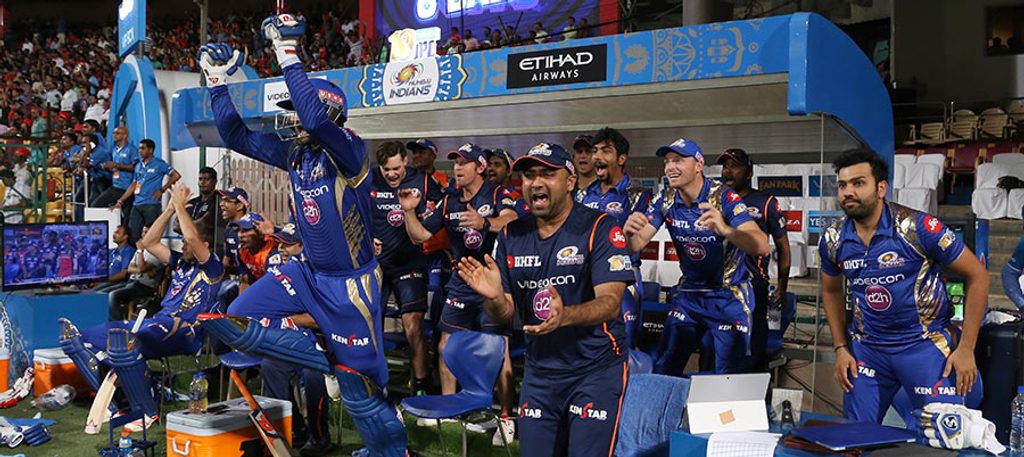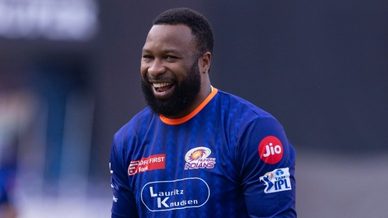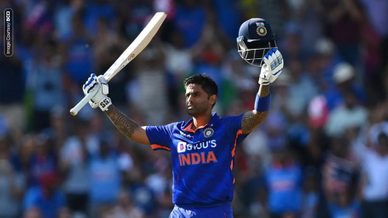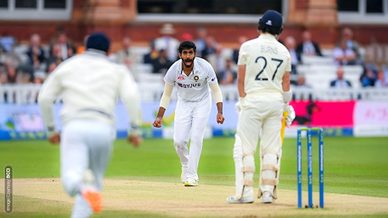
A Celebration of Mumbai Indians
What constitutes a successful team? Or, to put it better, how do we gauge it? For some, in a sporting context, success constitutes trophies lifted, for others, it’s about how the team inspires its fans day-in, day-out.
Mumbai Indians was one of the 8 founding teams of the Indian Premier League, back in 2008. We played our first match against the Royal Challengers Bangalore, which we lost in the final over courtesy a special innings from Mark Boucher. Fast forward to 2017: In our last match, which was another valiant loss (to the Rising Pune Supergiant), we chalked up a significant milestone. This was our 170th Twenty20 (T20) match, not a particularly significant number in-and-of itself. However, this number indicated that Mumbai Indians now moved past Somerset and have contested the most T20 matches in the format’s short history!
| Teams | Matches |
|---|---|
| Mumbai Indians | 170 |
| Somerset | 169 |
| Hampshire | 166 |
| Royal Challengers Bangalore | 163 |
| Surrey | 158 |
And after having played so many matches, it’s natural that we won a few. 97 to be precise, the most by any team in this format. That’s another record that we can be rightly proud of. Thus after a slow start, Mumbai Indians, as of this very moment, is the most successful T20 side the format has witnessed.
| Teams | Wins |
|---|---|
| Mumbai Indians | 97 |
| Chennai Super Kings | 94 |
| Lancashire | 90 |
| Hampshire | 87 |
| Warwickshire | 85 |
As everyone who is deemed ‘successful’ can attest to, success really isn’t an end-point. The process of continued excellence is another facet of what constitutes this elusive goal. Success can also be measured by resilience: A team managing to bounce-back after adversity. We started slowly in the inaugural edition of the IPL, losing our first four matches on the trot. We immediately turned this around with a 6-match win-streak. During this, a team performance blew away Kolkata Knight Riders for 67 at our fortress, the Wankhede. It’s still the third-lowest team score overall in the IPL, and the lowest whilst batting first. We chased that down with the powerplay still going on, in just 5.3 overs. The next season, we repeated the dose again against the Knight Riders, as the iconic duo of Sachin Tendulkar and Sanath Jayasuriya put on 127 runs to propel us to 187, a total well beyond their reach as it would turn out. As a sign of our dominance, that partnership was more than the Knight Riders managed, collectively! Despite this dominance our search for an elusive semi-final berth continues as we finished outside the top-4 for the second year running.
2010 was the season in which we truly asserted ourselves as we topped the IPL table for the first time. Our talisman, Sachin Tendulkar was at the forefront, not just for MI, but in the IPL as he ended up with the Orange Cap with 618 runs at a strike rate in excess of 130. In a season replete with wins, perhaps was the first victory was the most cherished, coming as it did against the inaugural Champions, the Rajasthan Royals. Another even batting performance catalyzed by fifties from Ambati Rayudu and Saurabh Tiwary resulted in us putting up 212 runs on a belter of-a-pitch at the Brabourne Stadium. Despite a fabulous century by Yusuf Pathan, it was our quicks, Lasith Malinga & Zaheer Khan whose combined figures of 2/49 off eight overs, stole the show. We ultimately prevailed by the slimmest of margins, just 4 runs.
For many fans, 2011 is synonymous with the ODI World Cup victory by the Indian national cricket team. For the Mumbai Indians team, playing in an expanded 10-team tournament, our Elimination Final victory over the Knight Riders was perhaps our most poignant. That we were able to grab a top-4 spot was largely in part to the lethal new-ball duo of Lasith Malinga and Munaf Patel. Malinga and Munaf were the top two bowlers in the tournament with 28 and 22 wickets respectively. It’s amazing to note that all our 5-fors in the IPL came in this season itself: Lasith Malinga claimed our first when he took 5/13 against the Daredevils, hastening their collapse for 95. Harbhajan Singh then took 5/18 against the Super Kings as we gained a modicum of revenge for our defeat at their hands in the final of the previous season’s tournament. That man again, Munaf Patel took our third 5-for for the season (5/21), against the Kings XI Punjab, as he dismissed 4 of the top 5 batsmen.
Our top-4 finish in IPL 2011 also enabled us to qualify for the Champions League Twenty20 tournament (CLT20). We channeled the hurt of losing the 2nd Qualifying Final of the IPL to the Royal Challengers Bangalore, into motivation for this tournament and it worked! We won our first piece of silverware as we avenged this loss by defeating the very same team (RCB) in the final, by defending 139 at Chennai. Again, it was the experience of Harbhajan Singh & Lasith Malinga (combined figures of 5/43 in 8 overs), that got us over the line. To add the icing onto the proverbial cake, Harbhajan Singh was named the Man of the Match in the Final; Lasith Malinga was named Man of the Series for this tournament.
In 2012, we qualified for our third successive semi-finals berth by qualifying 3rd on the league table. We saved our best against our neighbours (the Pune Warriors India) as we managed to defend a paltry 120 on a tricky Pune track. It was the trio of Munaf Patel (1/24 off 4), Lasith Malinga (2/25 off 4) and Harbhajan Singh (2/18 off 4) who swung the match in our favour with incisive and restrictive bowling at the same time. Despite this, we again encountered heartbreak at the hands of the Chennai Super Kings, losing the Elimination Final by 38 runs. The CLT20 that year wasn’t kind to us, either, as we were knocked out in the group stages.
After five seasons of bad luck and unfulfilled potential, the tide finally turned for the Mumbai Indians. With the leaner, meaner Mitchell Johnson adding to our pace battery, we finally got one back on the Chennai Super Kings, winning both home and away encounters against the team during the league stages. However, the most crucial match of all, the fourth encounter between the two sides that season, was the Final of IPL 2013. A floundering innings was resurrected by a 48-run stand between Ambati Rayudu and Kieron Pollard. Pollard cut loose towards the end of the innings and ended up with 60 off 32 balls: Combined, the rest of the team could not even manage a run-a-ball. Despite a Dwayne Bravo 4-for (an expensive one at 4/42) and a brilliant Dhoni 63 off 45 balls, Mumbai triumphed over the Super Kings by 23 runs, with the big man for the big occasion, Kieron Pollard adding 1/34 off his 4 overs and was adjudicated the Man of the Match.
Mumbai Indians entered the 2013 CLT20 with quiet confidence, but lost the first match to the Rajasthan Royals, bowled by a washout against Otago. It was simple, we needed four successive victories to ensure we became the second team to win the IPL and CLT20 in the same year. And that’s precisely what we did. We secured successive victories over the Highveld Lions (by 7 wickets), Perth Scorchers (by 6 wickets) and Trinidad & Tobago (by 6 wickets). We came up against the Rajasthan Royals in what was billed as the final showdown between Sachin Tendulkar and Rahul Dravid. Despite winning our last three matches chasing, we lost the toss and batted first. Although no batsman managed a fifty, we managed to post 202 on the board as Dwayne Smith (44 off 39), Rohit Sharma (33 off 14) and Glenn Maxwell (37 off 14) played significant hands. This didn’t look like being remotely enough as Sanju Samson and Ajinkya Rahane stitched together a 109-runs stand at nearly 10 runs an over, but Pragyan Ojha managed to prise Samson out for a quickfire 60 off 33 balls. It was a procession of wickets as the last 9 Royals wickets fell for just 52 runs. We became the second team to manage the double of the IPL and CLT20 in the same year!
There was bound to be a dip after the highs of 2013, but with the boys winless after the initial leg of the IPL in the United Arab Emirates, things were looking bleak. A change of country suited us just fine as we won 7 of the next 9 matches to book our place in the playoffs. It was nearly not to be as we entered the final league stage match of the season requiring a win off around 87 balls to book a place, if batting second. Mumbai’s collective heart sank, however, as the team conceded 189 runs in 20 overs, implying the required rate for qualification was more than 13 runs to the over. Corey Anderson, till that point fairly quiet in the tournament, unleashed his inner beast and walloped 95 off just 44 balls, but as Rayudu holed out after the 87th ball in search of victory, it proved to be futile. Or did it? The calculations had been made with the second team’s score at 190, which meant that a big hit off the next ball would still clinch it for us. In walked Aditya Tare, and with all the confidence in the world smashed James Faulkner for a towering six to ensure we sneaked past the Royals on net run rate. Nevertheless, this pulsating match took a lot out of our boys and unfortunately, we weren’t able to win back-to-back IPL tournaments.
The next year saw us again start slowly, with us losing each of four opening matches. We clawed our way back with a spirited victory over Royal Challengers Bangalore to kickstart our campaign and by the end of the group stages we found ourselves 2nd to Chennai Super Kings. A victory over CSK in the 1st Qualifier saw us get a vital break before the all-important Final. The team managed to post 202, the same total we posted in the Final of the 2013 CLT20. This time it was Lendl Simmons (68 off 45) and Rohit Sharma (50 off 26) who led the way with a 119-run stand for the 2nd wicket. A 71-run stand between Kieron Pollard and Ambati Rayudu ensured we capitalized on the start that Simmons and Rohit provided. Putting runs on the board in any Final brings with it significant scoreboard pressure. In the face of some sustained, hostile bowling, Chennai Super Kings managed just 161 in their 20 overs. Lasith Malinga and Mitchell McClenaghan registered the brilliant figures of 5/50 off 8 overs. All 5 of their victims were batsmen in the top 6.
In 2016, we continued the knack of slow starts to the IPL season as we managed to win just one of our opening four matches. In a tournament dominated by chasing sides during the initial stages, our encounter against Delhi Daredevils stood out. After being inserted to bat at our adopted home ground of Visakhapatnam, our youngsters shone through. Batting first, we pretty much killed the contest courtesy a fantastic 86 off just 37 balls by Krunal Pandya. Smashing six sixes, one more than Delhi could manage as a team, this was truly his breakthrough innings. In the face of such a large chase, Delhi could not manage to match the total and folded a whopping 80 runs short of the target. Credit for hastening the Daredevils’ demise goes to Jasprit Bumrah whose 3/13 were the standout figures of the night. Ably assisting Bumrah, with his accurate slow left-arm orthodox, was that man again, Krunal Pandya who managed 2/15, including claiming the honour of the victory-sealing ball, by castling the venerable Zaheer Khan. This was MI’s third biggest victory in terms of runs in the IPL, but unfortunately, we fell short of qualifying for the semi-finals for the 7th successive season and ended up 5th. In terms of numbers, MI managed to be in the top-4 of every single Indian Premier League for six-successive seasons from 2010 till 2015. During this period, we managed to win the IPL twice, in 2013 and 2015 and the Champions League Twenty20 Trophy (CLT20) twice, in 2011 and 2013.
But that’s history, so let’s turn our focus back to the current season. After we lost the opening match to a Steven Smith special, we were in a tough situation against Kolkata at home. We needed 49 runs off our final 3 overs for victory, which we chased down with 1 ball to spare, courtesy Hardik Pandya and Nitish Rana. What of the performance against Royal Challengers Bangalore? 7/4 inside the Powerplay, before Kieron Pollard played the innings of his life in an MI jersey to carry us home? And the carnage at Indore – when Buttler, Parthiv Patel and Nitish Rana made short-work of a target that was nearly 200? All these instances perfectly illustrate the never-say-die attitude that pervades the team dressing room and is a crucial component of a winning mentality.
That brings us on to you, the fan, the most important component of any team. Without the Paltan who cheer on the team passionately and vociferously, equally in victory and defeat, the Mumbai Indians would not be the force that it finds itself being at this point. We devote an entire home match to children from our ‘Education For All’ initiative, each and every season. What’s better than tens of thousands of adoring children passionately cheering on every diving stop, every wicket taken, every six smashed, to motivate our players? With the team having won 4 trophies in the intervening years, we want to thank you, the fans, for all your support in creating the enduring legacy and success of the Mumbai Indians.





